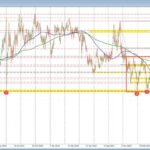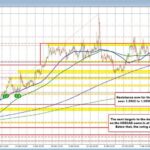
USD/CHF Currency Pair: Navigating Downward Pressure Amid Economic Uncertainty
Tháng 4 11, 2025
USD/CAD Currency Pair: Navigating the Bearish Trend and Market Outlook
Tháng 4 11, 2025Understanding the Recent U.S. Treasury Bond Market Selloff: Implications and Concerns
The recent upheaval in the U.S. Treasury bond market presents a significant alarm for policymakers and investors alike. What started as a routine market trend has turned into a profound indicator of varying confidence in the nation’s financial stability. The sharp selloff, particularly in the 10-year Treasury notes, has triggered discussions surrounding the potential implications for economic recovery and broader fiscal policies.
Current Bond Market Dynamics
Recent Market Movements
The U.S. bond market has witnessed a tumultuous shift, marked by a notable selloff in Treasury bonds. Recent movements indicate that yields for 10-year notes have surged, peaking at approximately 4.51%, a level not seen in years. This volatility culminated in the largest weekly increase in yields within the past decade, settling recently around 4.27%. Such significant movements have raised eyebrows and drawn parallels to previous financial crises, reflecting underlying market vulnerabilities where stability is typically the norm.
Influence of Macroeconomic Factors
The selloff does not occur in a vacuum; it has been influenced by macroeconomic factors that lower investor confidence. The initial trigger stemmed from an announcement by former President Donald Trump regarding sweeping tariffs, which rattled investor sentiment. Although a temporary pause on these tariffs offered a short respite, the underlying sentiment of instability persisted. This emphasizes a broader issue: a declining confidence among investors, as indicated by rising yields amid escalating equity market conditions, which usually provide stability.
Role of Hedge Funds
Hedge funds have significantly amplified the selloff through leveraged trades, particularly in relation to complex financial strategies known as basis trades. These strategies can lead to forced selling when market conditions become unfavorable, thus heightening the market’s fragility. The pressure created by hedge funds demonstrates a potentially precarious financial environment, prompting liquidations to cover margin calls and further exacerbating volatility within the bond market.
Implications for Policymakers
Increased Borrowing Costs
An immediate consequence of rising yields in the Treasury market is the increase in borrowing costs. This trend adversely affects not only the government but extends to consumers and businesses. Since a significant portion of loans and mortgages are tied to Treasury yields, these heightened costs could impede efforts for economic recovery, especially as inflation remains a persistent concern. For more insights on the impact of rising borrowing costs, see Top Investment Mistakes to Avoid in 2023.
Pressure from “Bond Vigilantes”
The current climate has seen the emergence of what some market participants refer to as “bond vigilantes”. These investors demand higher yields in response to perceived irresponsible fiscal policies. Their actions implicitly compel policymakers to stabilize the market, as failure to do so may result in further hikes in borrowing costs and economic contraction. This situation serves as a disciplinary measure against lax governmental financial strategies.
Potential for Stagflation
Economists are growing alarmed about the potential for stagflation—a scenario characterized by high borrowing costs combined with stagnant economic growth and rising prices. Such a climate would severely hinder the administration’s ability to advance its policy agenda and could have profound political ramifications, particularly as the 2026 midterm elections loom closer. Understanding these dynamics can also help in recognizing some of the psychological pitfalls investors should avoid, as discussed in Barry Ritholtz’s blog on investment mistakes to avoid for success.
Conclusion
The current predicament faced by the U.S. bond market underscores critical concerns for policymakers and stakeholders within the financial ecosystem. The emerging trend of rapid bond selling signifies an urgent need for a reassessment of fiscal policies and their influence on market confidence. As these dynamics continue to evolve, the potential repercussions for the broader economy—a mix of stagnation and increased financial burdens for consumers—demands vigilant monitoring and prompt intervention to ensure stability in the financial landscape. For a deeper exploration of value investing strategies that may still hold relevance in this complex environment, check out 3 Reasons Greenblatt Says Value Investing Beats the Market.
